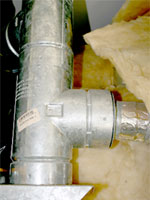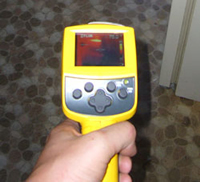Do-It-Yourself Home Energy Audit
The following text comes from "A Consumer's Guide to Energy Efficiency and Renewable Energy," which is at the U.S. Department of Energy's Energy Efficiency and Renewable Energy website.
Insulation
Heat loss through the ceiling and walls in your home could be very large if the insulation levels are less than the recommended minimum. When your house was built, the builder likely installed the amount of insulation recommended at that time. Given today's energy prices (and future prices that will probably be higher), the insulation level might be inadequate, especially if you have an older home.
Inspect the Attic

If the attic hatch is located above a conditioned space, check to see if it is at least as heavily insulated as the attic, is weather stripped, and closes tightly. In the attic, determine whether openings for items such as pipes, ductwork, and chimneys are sealed. Seal any gaps with an expanding foam caulk or some other permanent sealant.
While you are inspecting the attic, check to see if there is a vapor barrier under the attic insulation. The vapor barrier might be tarpaper, Kraft paper attached to fiberglass batts, or a plastic sheet. If there does not appear to be a vapor barrier, you might consider painting the interior ceilings with vapor barrier paint. This reduces the amount of water vapor that can pass through the ceiling. Large amounts of moisture can reduce the effectiveness of insulation and promote structural damage.
Make sure that the attic vents are not blocked by insulation. You also should seal any electrical boxes in the ceiling with flexible caulk (from the living room side or attic side) and cover the entire attic floor with at least the current recommended amount of insulation.
Checking Walls

Checking a wall's insulation level is more difficult. Select an exterior wall and turn off the circuit breaker or unscrew the fuse for any outlets in the wall. Be sure to test the outlets to make certain that they are not "hot." Check the outlet by plugging in a functioning lamp or portable radio. Once you are sure your outlets are not getting any electricity, remove the cover plate from one of the outlets and gently probe into the wall with a thin, long stick or screwdriver. If you encounter a slight resistance, you have some insulation there. You could also make a small hole in a closet, behind a couch or in some other unobtrusive place to see what, if anything, the wall cavity is filled with. Ideally, the wall cavity should be totally filled with some form of insulation material. Unfortunately, this method cannot tell you if the entire wall is insulated, or if the insulation has settled. Only a thermographic inspection can do this.
The Basement
If your basement is unheated, determine whether there is insulation under the living area flooring. In most areas of the country, an R-value of 25 is the recommended minimum level of insulation. The insulation at the top of the foundation wall and first floor perimeter should have an R-value of 19 or greater. If the basement is heated, the foundation walls should be insulated to at least R-19. Your water heater, hot water pipes and furnace ducts should all be insulated. For more information, see our insulation section.









